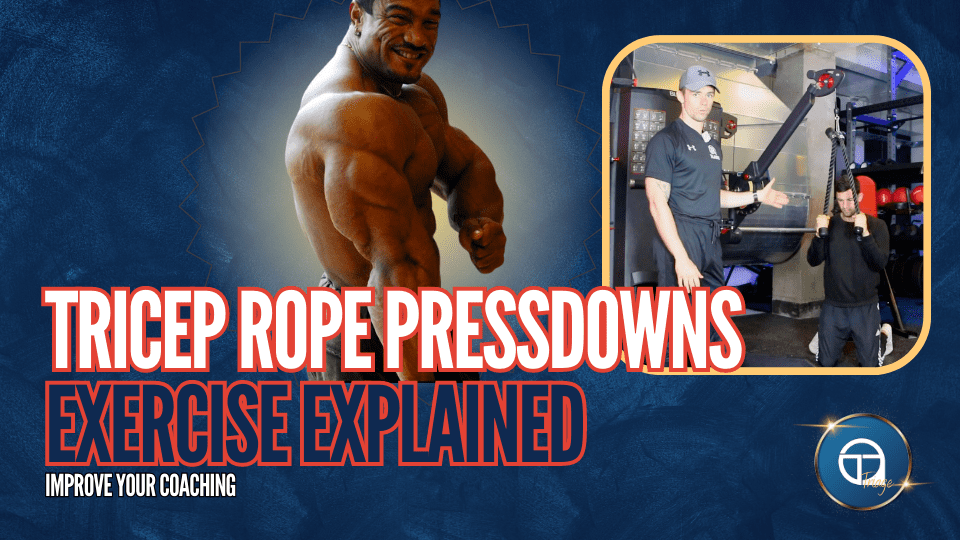Tricep rope pressdowns are very effective for building the triceps, and today we’re going to discuss how to perform them effectively and then go through a couple of different variations of tricep rope pressdowns. Just to give you guys an idea of what different tools are at your disposal and also different programming strategies that you can use to change the exercise experience for individuals and maybe create some sort of drop sets or mechanical drop sets within your programming.
Tricep Rope Pressdowns – Proper Technique and Modifications
Now, the first thing I want you to make note of is the fact that when you use the rope attachment, you’re not just dealing with the line of force that comes from the cable itself. Generally, when we talk about cable machine variations of exercises, such as a cable row, then the handle that I’m using is the same as the line of force. The line of force is effectively the line from the cable going straight down through the handle. However, that’s a little bit different on the rope attachment because it splits apart. This isn’t the case if you’re holding the rope in such a way that as you complete a rep of tricep rope pressdowns the rope is still straight and effectively connected into one single rope, then the line of force is also still straight. But when you don’t do this, and you perform the exercise like most people do, what begins to happen as you pull that rope apart is that you’re now pulling at an angle to the line of force. That actually changes the resistance that you’re dealing with. If you were to totally exaggerate this and pull the rope totally apart, you now have this additional challenge where you now have to push your arms out away from each other. The further that’s exaggerated, the less vertical force is being produced. So, you end up not applying as much force to move the weights attached to the cable because all the force is being dissipated outwards.
As a result, if you go through a couple of reps of a standard tricep rope pressdowns and you spread it at the end, the resistance you feel is actually increasing a lot as you get to the bottom of the standard variation. What some people will find is that they’ll have to choose a weight tricep rope pressdowns that’s really, really easy at the top for them, but really, really hard at the bottom. Because of this, we end up in a position where a limiting factor is actually our strength in that shortened position, and as you fatigue there, you might be fatigued in the fully shortened position, but you haven’t actually trained the rest of the range of motion very effectively. So, the point at which you reach failure or concentric failure is going to be different than what it might be on an exercise where the resistance was more consistent throughout the range or better fit your capacity to produce force. Now, one way that we can actually start to overcome this is by adding a second rope. If you add a second rope to your tricep rope pressdowns, this does actually overcome the problem that we’re dealing with initially. When you have that rope initially, you get a large angle at the bottom. The greater the angle between the two ends of the rope and the line of force, the greater the challenge is going to be in that bottom position, and when you are using a single rope attachment, the angle between the end of the rope and the line of force is often around 45 degrees or more.
However, when you begin to use two ropes for your pressdowns, what you’ll see is that the ropes remain more vertical throughout and you have a much smaller angle between the two ropes. The only downside is that if you are quite tall, you’re going to have to kneel down to perform the exercise. But with two rope attachments, you will see that the angle doesn’t change quite as much, and as a result, we don’t get that massive change in the resistance throughout the range. Initially, what we saw with the single rope was that we were starting with two straight lines and finishing with two lines at 45 to 60 degrees. Whereas with two rope attachments, you will maybe have somewhere between a 15 to 30-degree angle at the top, and maybe we’re talking like a 25 to 40-degree angle at the bottom. So, we’re not seeing a massive change in terms of the resistance that’s coming from the rope or the implement that we’re pulling itself.
That’s something that’s really important to keep in mind because very often you will have a client who says, that they just find it real difficult to get to the bottom position, or what you might see is that when they get to the bottom, they might use a bit of momentum or they’ll roll their shoulders inward to finish the rep. If you’re seeing that happening, then using two rope attachments can be really helpful. However, if you don’t have access to a second rope, what you can also do is just provide a bit of a spot to your client and help them to complete the rep. As they go through a rep and get into that bottom position, what you can start to do is just assist them into that bottom part of the range by holding onto the cable itself and giving support, and then they can do the eccentric themselves. They can do most of the range of motion themself, and you would just apply a little bit of support to help them get into the end of that range. That allows them to get a nice challenge throughout the range of motion without being limited by just that one part.
Now, it is important to realise that, you don’t have to make the exercise absolutely perfect. If I have a client and they’re using an implement like the regular rope and it’s easily accessible for them, they’re having no issues, their triceps are blowing up, and their elbows are fine, then I’m not going to be jumping in with 20 suggestions about how we can improve it. Because we want to keep things simple and we want to keep things practical so that when our clients do visit the gym themselves, they don’t have to go setting up a million different things.
All of these different types of implements and these different adjustments to the exercise become really useful when we’re trying to troubleshoot. For example, when we have that client with elbow pain, when we have that client that’s struggling to train their triceps effectively, or we have that client who just hates this exercise because of how difficult it is at the bottom. That’s where you start to bring in these changes.
Now, with all that said, there are additional adjustments you can make to this exercise. If you stand in front of the cable station and perform the exercise, what you’ll find is that with the elbows at about 90 degrees that’s the point at which the actual resistance from the cable itself is going to be greatest. This is because the line of force has the greatest distance from the elbow joint at this point. Then there’s a larger moment arm as you come down to the bottom of the movement, as the cable is really close. When the cable is really close to the elbow joint, the resistance from purely the cable is going to be much lighter here on the elbow if we don’t consider the actual rope. However, with the rope, that’s going to increase it a bit.
Now, if you were to lean over a bit in front of the machine to do your tricep rope pressdowns, then there’s a little bit of a difference here too. What we’ve got here is that the triceps, the long head of the triceps at least, they’re not going to be in their fully shortened position at the bottom of the movement. As a result, they won’t have that cramping sensation. Now, what’s also happening as you come to the top of the movement, you’re now also getting into a little bit more elbow flexion, and the triceps get more stretched than they do in the standard variation. This all depends on how much you’re leaned over.
Then another variation that you can do here is if you stand further away from the cable machine. What you can do is bend over a bit and perform the leaned-over tricep extension variation, but then also bring the arms back actively. This is another way that you can start to adjust this exercise by actually extending the elbow and then also extending the shoulder because the long head of the tricep also extends the shoulder. It’s a biarticular muscle and hence it has two functions. So, using those two functions of the tricep together will make this variation really effective.
What you could also do is just use this in a kind of dropset or superset, where you initially start with the variation where you’re just doing your pure tricep extension, and then, as you’re getting fatigued, you can start to do more of that shoulder extension and really milk the triceps for all they are worth. This is very effective if you’re someone that really wants to bring up that long head of the triceps. It’s also a really nice way of bringing some novelty into your training.
There are many different ways that you can perform tricep rope pressdowns. There are subtle differences between the variations, and we could also use different handles to change the way that the resistance changes and hence work with more clients. So, if clients are coming to you, they have elbow pain and haven’t been able to train their triceps, you now have the tools to begin to play around with some of these things. You also have the tool of spotting. If you find that they’re having points in any range of motion, whether it be this exercise or others, where they’re struggling to finish the rep and they’re finding it difficult, you can adjust that exercise for them by strategically spotting the exercise.
Hopefully, that gives you some stuff that you can apply here and in many other exercises in the gym. If you need help with your own training, you can always get in touch with us for coaching. If you are a coach and you want to upskill your nutrition coaching, we do also have a Nutrition Coaching Certification program. If you like our video content, then subscribe to us on YouTube!

Gary McGowan
Hey, I am Dr Gary McGowan, co-founder of Triage, qualified Doctor, Physiotherapist, and Coach.
Having graduated with first class honours in Physiotherapy (BSc) and Medicine (MB BCh BAO), I aim to blend medical science with a decade of coaching experience to help you maximise your performance, transform your body, and optimise your health.
I enjoy grappling, hiking, lifting, and other modes of physical training. When I’m not training, I like to read broadly, particularly philosophy, religion, and history. I love the natural world, particularly the mountains & lakes of my hometown Killarney, County Kerry.


